How pre-mix bowsers can help increase sprayer output
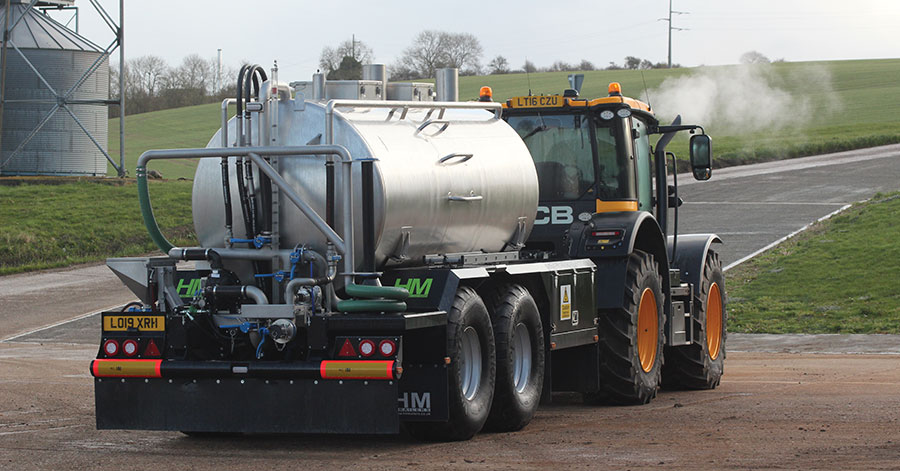
Like most farm kit, the cost of sprayers is on an upward curve, and this is partly driven by the increasing sophistication of the technology on board.
While this tech can increase application quality, it doesn’t always increase output, which is limited by appropriate speed, boom width and downtime spent filling and cleaning or on the road.
See also: How a £77 black box could bring spot spraying to the masses
If extra output is required – when taking on more land, for example – many are tempted to buy an additional sprayer to cover the ground at the right time, particularly in seasons where spray windows are limited.
However, with increasing scrutiny being placed on fixed costs, adding another depreciating asset to the machinery fleet isn’t always the best option.
Instead, spending anywhere between a few thousand and £50,000, depending on complexity, growers can increase output of a single machine to an extent where another sprayer might not be needed.
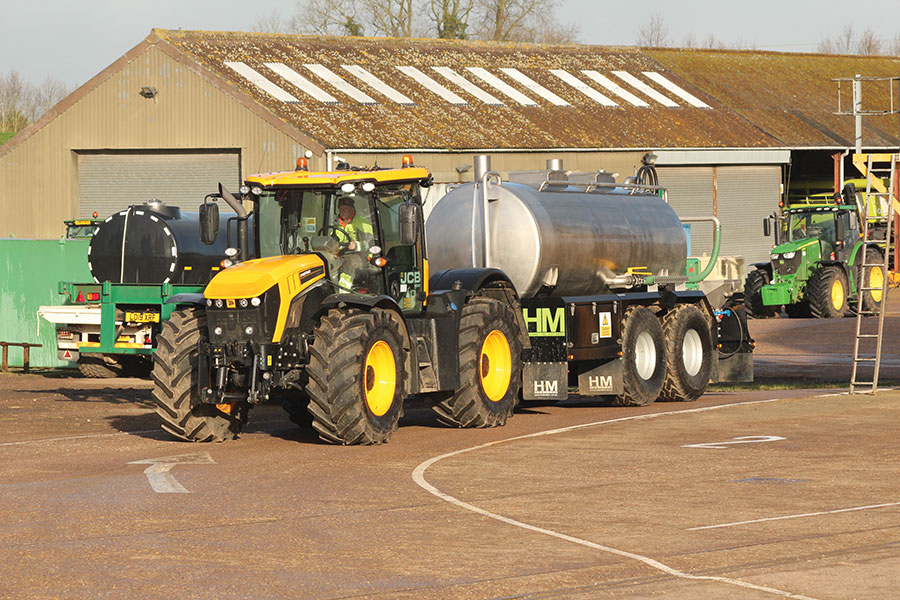
Growing trend
Contractors have long used bowsers, but bowser manufacturers all report a growing demand from arable farmers, largely driven by people switching to liquid fertiliser and taking on more land miles away from their base.
Work by agrochemical manufacturer Syngenta has shown that just having a simple bowser to carry water to the field can increase daily output by 26% over a standard spraying procedure where you trek back to the yard to fill up.
However, farms that have the staff to run a more complex bowser that allows chemical solution to be pre-mixed while the sprayer keeps working can increase output by a massive 72%.
Specialist stainless steel design and fabrication business Watson & Brookman engineer tanks and induction systems for most major sprayer and bowser manufacturers in the UK.
Its managing director, Clive Brookman, says although the firm focuses on part production, it has also assembled a number of complete pre-mixing bowsers for farmers in the past.
“Every one of them have commented that output has increased so much that they definitely didn’t need the other sprayer they were considering.”
He adds that in some cases, using a good bowser system can also decrease sprayer size requirement, so cutting costs, reducing axle weights and potentially causing less damage to soil structure during a wet season.
“If you are charging around, making big ruts in the autumn, they don’t disappear in the spring and that can make life difficult,” he adds.
Home-made options
A route that might save upfront costs is to source constituent parts independently and mount on an existing farm trailer, such as a flatbed or grain cart, during busy spraying periods.
Watson & Brookman can make tanks up to 20,000 litres for this purpose, using 304L-grade stainless for water and chemical solution and 316L-grade where corrosive suspension fertiliser is being carried.
The higher-grade material is 25-30% more expensive, so this should be factored into any buying decision.
There are also more cost-effective polyethylene horizontal sump tank options available from Enduramaxx, with the Lincolnshire-based manufacturer offering skid-mounted options from 2,000 litres up to 13,000 litres, with room for a pump engine and even an intermediate bulk container if required.
The final tank option is fibreglass, with Barnsely-based EB Engineering offering standard capacities up to 15,000 litres, but custom sizes can be made on request to suit specific needs.
Size matters
Mr Brookman says one mistake to avoid if going down this route is getting greedy and trying to assemble a bowser that can carry three or four sprayer loads. Often, the unit ends up too big, too heavy and too cumbersome, especially where it is used in field.
“It is great, until you get a wet season like we’ve just had, and you end up with a system you can only fully use for half the year. There is a balance to be struck.”
This is on top of any consideration about road safety where the bowser is likely to be used on public highways, with stability and stopping ability potentially compromised with oversized tanks on agricultural trailers.
Load-sensing brakes and adequate tank baffling can go some way to overcome this issue, but users must consider road regulations when building and using a homemade rig.
Usability
In addition to a basic tank and pump, some may opt to build in a pre-mixing unit such as a Homburg Handler or integrate an induction hopper into the setup.
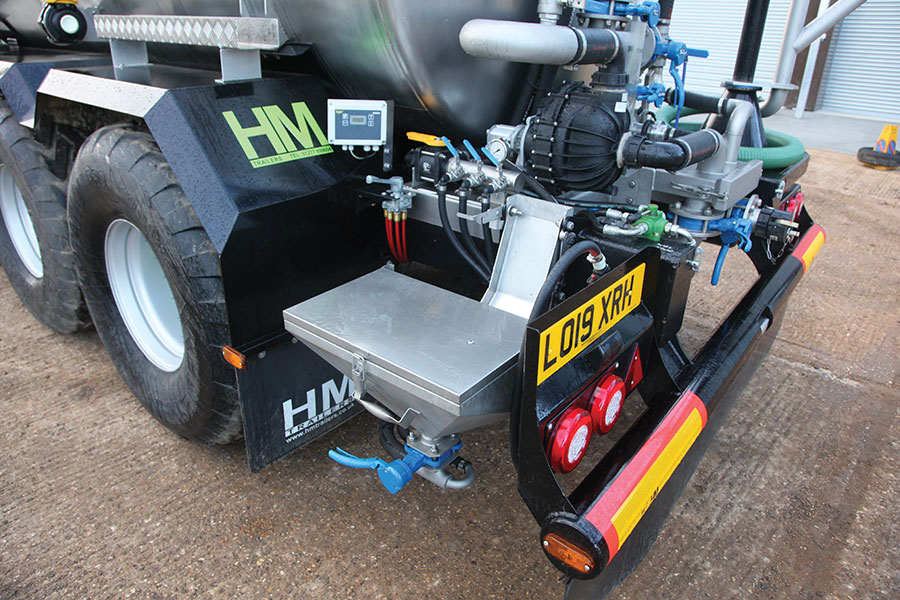
Induction hopper
This also has pitfalls, and Mr Brookman says careful consideration should be given to how these are laid out and plumbed in, to ensure any homemade system is usable.
“It sounds obvious, but there are a lot of people out there who try to make a bowser, but it’s not as good as it could be because they don’t give it enough thought.
“It’s like putting the Honda engine pump working right in the operator’s ear when using the chemical hopper. Initially, it isn’t a major problem, but it will make a difference when you are on it all day.”
To avoid any potential design issues, farmers can leave it to the experts. There are several manufacturers that can offer standard or bespoke bowsers for a range of needs. Here, we take a look at the options.
Dammann
Dammann recently launched its own pre-mix tank, which is an adapted version of its existing trailed sprayed kit – albeit without the booms.
The setup is completely customisable, so buyers can pick from any of the firm’s existing tanks. These range from 8,000-14,000 litres and include the standard 60-litre induction hopper, which can process 400 litres/min of fluids and three bags/min of Epsom salts.
Spec details include Dammann’s rotary tank cleaning and agitation system, as well as a 1,200-litre transfer pump to fill the sprayer.
Buyers can choose to mount the tank to their own flatbed trailer or get Dammann to provide the chassis.
Even here, there is the choice of a road-biased setup with lorry-style running gear, where the tank is mounted like a container via a twist-and-lock system.
If it’s likely to be hauled around fields and along tramlines, it can be ordered with the same twin-axle setup as the trailed sprayers.
The sprayer pack can also be removed to make use of the chassis at other times of the year.
Prices start at £35,000, excluding the chassis.
Bailey
Bailey has been producing water bowsers for about 10 years, firstly using second-hand stainless-steel tanks and, more recently, translucent fibreglass.
The switch means chassis are matched to tank, rather than the other way around, speeding up production time and standardising its product offerings.
Tanks are made by EB Equipment, come in 15,000-litre, 16,500-litre and 18,000-litre sizes and sit on a 20t chassis with sprung drawbar.
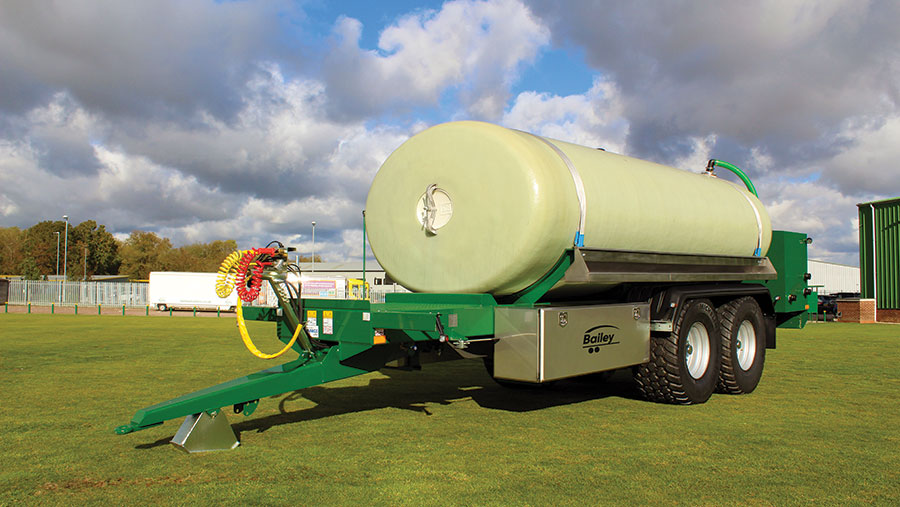
Bailey bowser
A single 1,000-litre/min petrol powered pump with 7.5cm outlets transfer liquid and comes with two extra-long hoses with Snaplock couplings.
Stainless steel side lockers and a rear locker with work and internal lights provide storage and a front platform can carry one intermediate bulk container when applying bulk products.
Commercial axles and 420×180 brakes come as standard, with air brakes an option for those doing plenty of road work at speed.
Currently, there is no option to introduce agrochemical into the tank, so any pre-mixing has to be done using a separate system or through the sprayer itself.
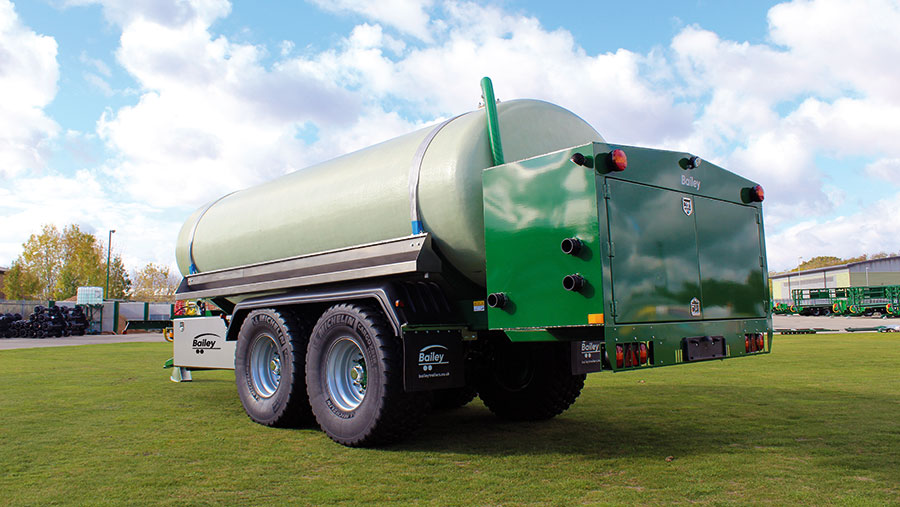
Bailey bowser
However, Bailey is in discussions with a third party to incorporate its induction hoppers into the bowser soon.
For current models, expect to pay about £20,000 for a 15,000-litre unit, with the largest, full-spec 18,000-litre bowser commanding closer to £30,000.
Merrick Loggin
Brackley-based Merrick Loggin trailers have been offering simple and cost-effective bowsers throughout its 45 years of trading.
Since 2012, the firm has been building its chassis around Enduramaxx polyethylene tanks, with the capacity and any extras specified to each customer’s needs.
It sells more than 20 units each year and its most popular model is a basic 10,000-litre, single-axle option. It comes with chemical lockers and hydraulic brakes, and most buyers will opt for a 750-litres/min Honda Pacer pump for transfer of liquid, all via 5cm plumbing.
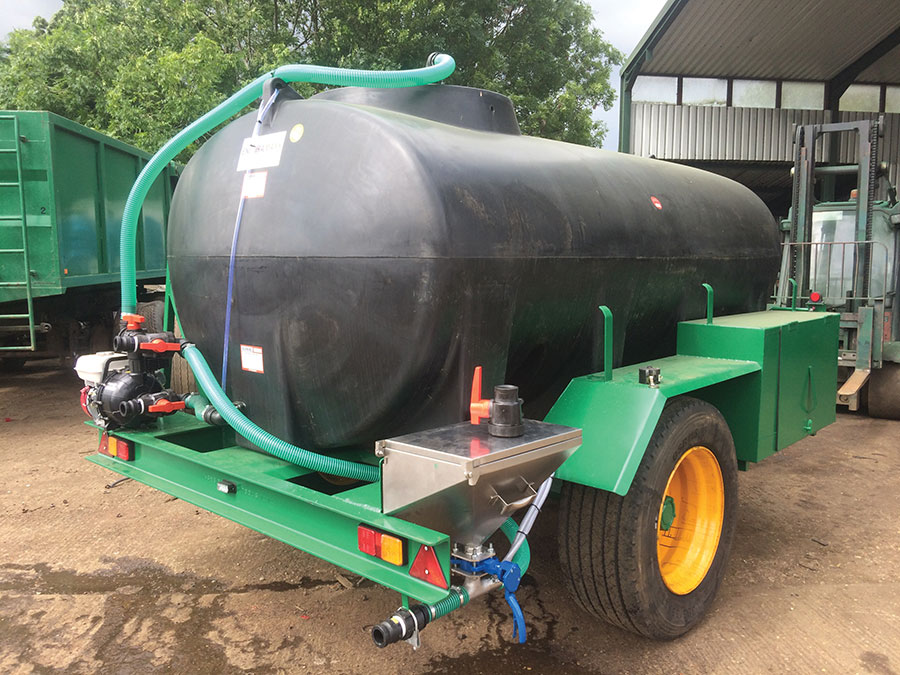
Merrick Loggin 10,000-litre bowser plus pump induction
Where customers request an induction system, the firm buys in a stainless-steel Watson & Brookman and incorporates it into its design.
A 10,000-litre unit is always kept in stock, but the firm makes 5,000-litre, 6,000-litre and 8,000-litre options to order. It also produces a larger chassis for a 13,000-litre tank.
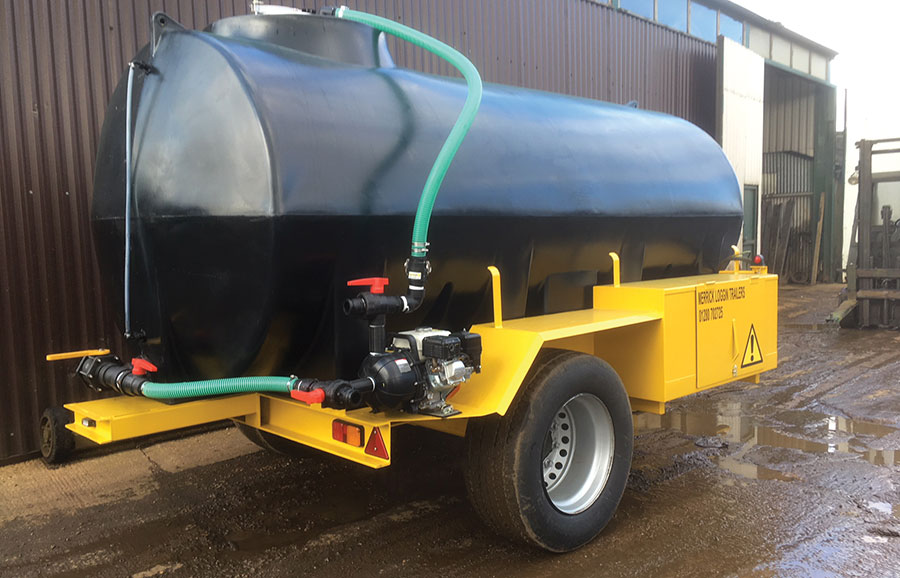
Merrick Loggin 10,000-litre bowser with pump
The 5,000-litre bowser costs £7,500, the 10,000-litre version is £9,000, and buyers can spec tandem axles on the latter for £11,500. The 13,000-litre unit has to sit on tandem axles and buyers can expect to pay £13,500. All prices include the pump and pipework (circa £1,000 each unit).
Trailers come with Super Single tyres, hydraulic brakes and chemical lockers as standard, with air brakes and low-ground-pressure tyres optional extras where required.
Vegcraft
One of the best-known names in the sprayer bowser market is Scottish firm Vegcraft. Instead of offering a set product range, every one of its machines is made to order.
The company’s Adam McDonald says that as farms and spraying operations vary so dramatically, Vegcraft doesn’t try to sell a bowser system that is overengineered relative to the client’s needs.
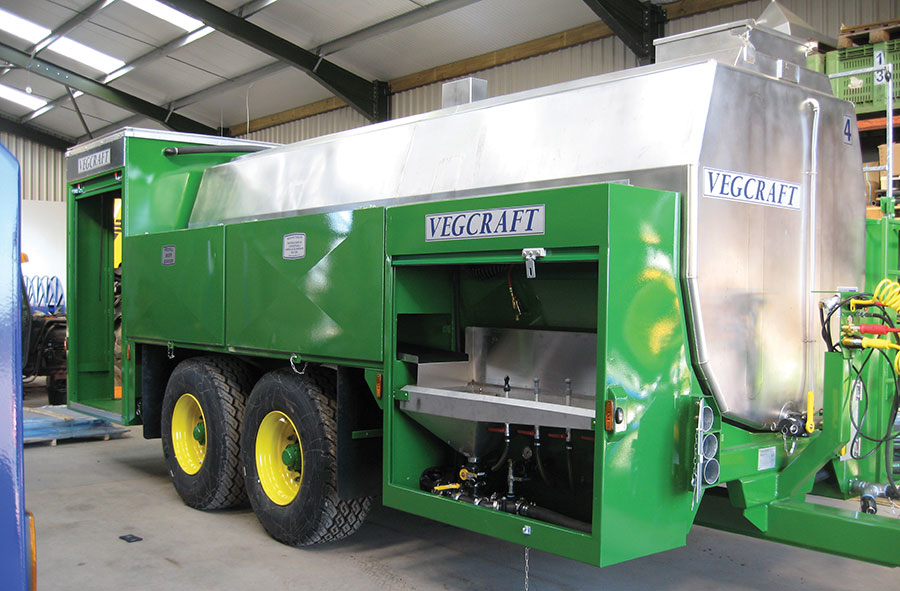
VegCraft bowser
Instead, a customer consultation explores factors such farm size, geographical spread, cropping and sprayer used, and a bespoke bowser is designed to fit.
Customers can choose between plastic Enduramaxx and Watson & Brookman stainless tanks. Plastic tanks have nooks and crannies that don’t suit life as a pre-mix bowser, as it is more difficult to keep sticky products agitated and prevent residue build-up.
Therefore, stainless tanks are advised if regularly carting pre-mixed spray solution. They are also more suited to higher road speeds, as baffling to help keep the load stable tends to be more effective.
The firm’s ProFill induction system can be integrated into its bowsers, and clean water tanks are also an option. Chassis and running gear sophistication increase with capacity, and for smaller models, agricultural axles and hydraulic braking usually suffice.
Vegcraft’s larger units – where water surge would normally be a concern – are always fitted with load sensing and air brakes for improved safety on the road.
Buyers can spec various pumps, with a range of outputs, storage space for chemical, personal protective equipment and spares, and all the usual options apply on tyres.
A 5,000-litre model with pump starts at £8,000, while a 16,000-litre split stainless-steel tank with pre-mix capability and lots of storage lockers will set you back more than £40,000.
HM Trailers
Essex farmer Grant Perry ventured into trailer building in 2000 and the Ongar-based business now produces a wide range of trailer models of all shapes and sizes.
Bowsers were added to its portfolio in 2013 after it successfully assembled a unit for a neighbouring contractor to boost his sprayer output.
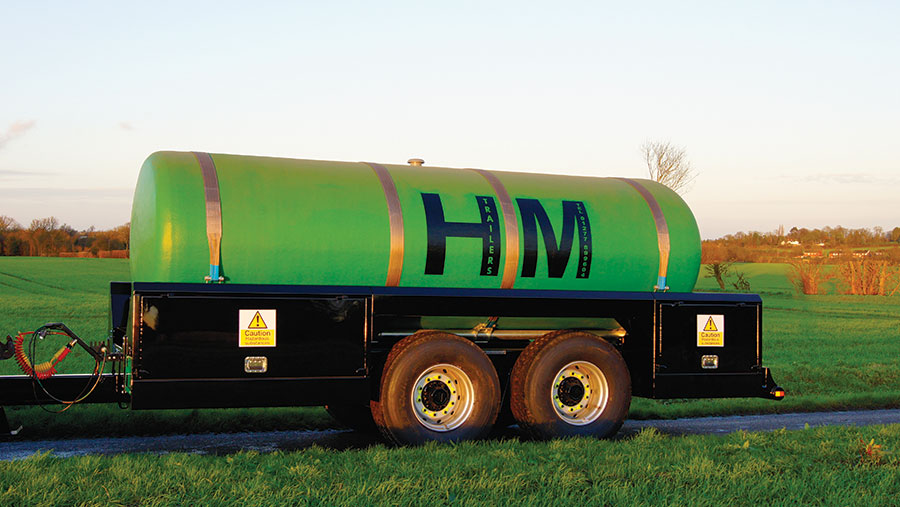
HM Trailers bowser
Demand has grown steadily since, along with what its bowser concept offers in terms of complexity and, in particular, stability.
The company has worked hard to drop the centre of gravity on its bowsers, making them safer and more stable on the road. Sinking oval tanks deep into a low chassis are examples of how it is achieving this.
Like Vegcraft, HM Trailers run a bespoke service and sees a bowser size range from 5,000-10,000 litres as most appropriate, in line with modern sprayer capacities.
The firm fit either Watson & Brookman stainless or EB Equipment composite tanks to its chassis, and a range of petrol and hydraulically driven pumps are available up to 1,400 litres/min. Plumbing can be 5cm or 7.5cm, depending on size of pump chosen.
In the past, Homburg Handler units have been installed to the rear of its pre-mix bowsers, but these are clunky and likely to be superseded by integrated induction hoppers in future models.
For chassis and running gear, users can request any specification to suit, with a choice of hydraulic or air brakes, sprung or air suspension and Super Single or flotation tyres, depending on size and road time.
Storage space varies with trailer size, but the largest units can have up to 1,000 litres in locker space for agrochemical, personal protective equipment, spill kits and spares.
As a price guide, the 8,500-litre high-spec bowser featured in our case study cost about £55,000.
Case study: Bedfordia Farms upgrades pre-mix bowser setup
One Bedfordshire arable unit has just taken delivery of a tailor-made HM Trailers bowser system to optimise output of its new self-propelled sprayer and improve worker safety.
In the past, Milton Ernest-based Bedfordia Farms ran one 40m, 5,000-litre Bateman RB55 and chased it with a 5,000-litre Bateman spray pack mounted on a twin-axle trailer.
The system worked well, until another RB55 was added to the kit list to cover an increased cropping area, which now stands at 2,150ha spread within a nine-mile radius of the main yard.
The single bowser unit only allowed one of the two sprayers to be backed up fully, so the second machine’s output was often compromised.
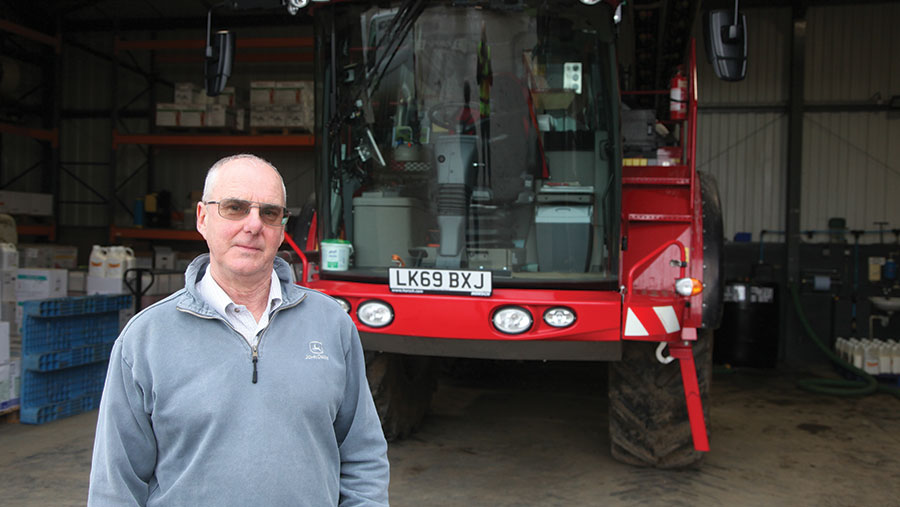
Farm manager Ian Rudge
Spraying appraisal
A recent appraisal of the spraying operation by arable manager Ian Rudge and his team highlighted the issue, among others, and has led to several changes.
Firstly, tramline widths had to be cut from 40m to 36m to accommodate digestate application through a local contractor’s Vredo slurry spreader with 36m dribble bar.
Mr Rudge then needed a narrower sprayer and opted to replace the two Batemans with an 8,000-litre Horsch Leeb PT280, which now applies all agrochemical and liquid fertiliser to the farm’s winter wheat, oilseed rape and bean crops.
To get anywhere near the output of two 40m machines, a bigger and smarter bowser was needed, and Mr Rudge joined up with HM Trailers and visited the Horsch family’s farm in Germany to see its “Shuttle” sprayer in action.
Horsch’s Shuttle is essentially an 8,000-litre tank with a Vogelsang 3,500-litres/min positive displacement (PD) pump, hooked on top of an articulated trailer.
Chemical is pre-mixed in the chemical store, then water and chemical solution are sucked into the bowser concurrently and it’s towed with a lorry to sprayers running within a 40- to 50-mile radius.
Although impressive, Mr Rudge believed the pump runs at too high a pressure, so shutting valves off could result in blown pipework and spillages.
It also didn’t have the flexibility of its own integrated induction bowl and costs £55,000 for the tank and pump unit alone.
“We just saw too much risk in it, and the price of the shuttle is as much as our whole new system has cost,” he adds.
New system
That new system is now on farm and has an 8,500-litre stainless steel Watson & Brookman baffled split tank and induction hopper at the rear, all mounted on a high-speed HM Trailers chassis and pulled behind a Fastrac 4220.
Also incorporated into the bowser are two centrifugal pumps and a 7.5cm gantry transfer system, which swings out and connects via an overcentre coupling at the front of the sprayer.
A 400-litre/min pump with high pressure is used for filling and incorporation of chemical, and a larger second pump can transfer out the mixed solution at up to 2,000-litres/min. This high-volume pump can also be used to fill and transfer liquid fertiliser.
A decent quantity of chemical and personal protective equipment storage can be found in lockers along the sides of the chassis, plus there is an 800-litre clean water tank for rinsing and handwashing.
A Teejet digital tank level gauge has been fitted for accurate filling control, but there is also a manual gauge at the rear.
As the farm’s bunded filling area is sloped and the trailer is never parked completely level when loading, its air suspension and a remote-control panel allows the operator to level it up.
Avoiding spills
This ensures the sight gauge is giving the most accurate reading when filling and helps to avoid spills, especially if foaming occurs.
When the tank has finished emptying into the sprayer, valves are shut off and the air system is also used to vent all the pipework into the sprayer, reducing potential drips and residues.
Mr Rudge says good access to the tank and around the machine allows it to be pressure washed and the transfer pipe storage is also well thought out by its designers.
“The other attraction is that it is produced here in the UK, so the support is there. Both Watson & Brookman and HM Trailers have been straightforward to deal with and keen to get things right. The quality of what they’ve built is very good,” he adds.
All chemical mixing is done in a central bunded chemical store and fill-up area, where all product is unpacked and palletised on arrival.
There is 250cu m of liquid fertiliser storage at the main farm and a further 140cu m off site. Trace elements are stored in bulk within the chemical store, which is both cost-effective and avoids dealing with large numbers of intermediate bulk containers.
Staff wellbeing
The impressive setup is obviously geared up for efficiency, but Mr Rudge says the wellbeing and safety of staff is also a big factor in how the farm’s modern spraying system has evolved during its seven-year lifespan.
It allows a busy workload to be shared between dedicated sprayer and bowser drivers Darren Bird and Steve Morris.
When bowser operator Mr Morris is waiting for the sprayer, he can have a break and, conversely, when the sprayer is being filled, Mr Bird gets a chance to catch up on paperwork, have a cuppa and stay fresh.
“They get tired and that’s when mistakes occur, but with this whole process, we are engineering out some of the risk,” explains Mr Rudge.
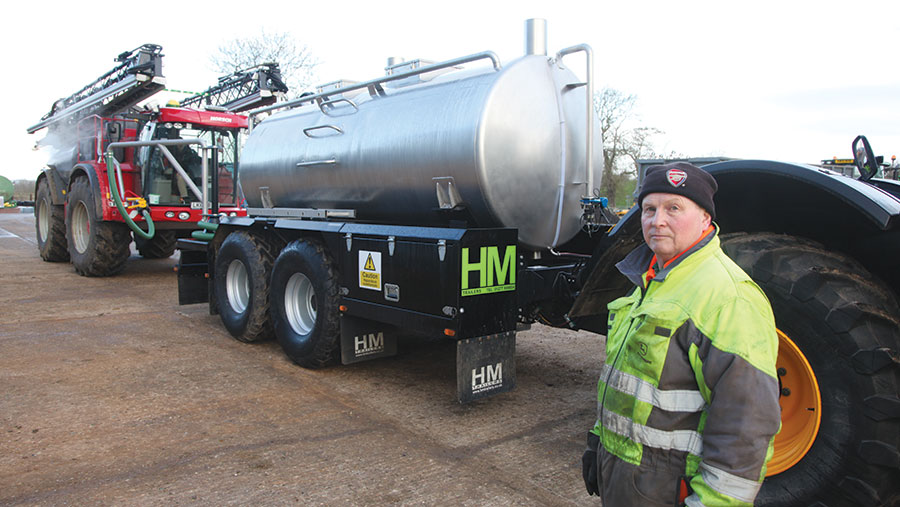
Bowser operator Steve Morris

